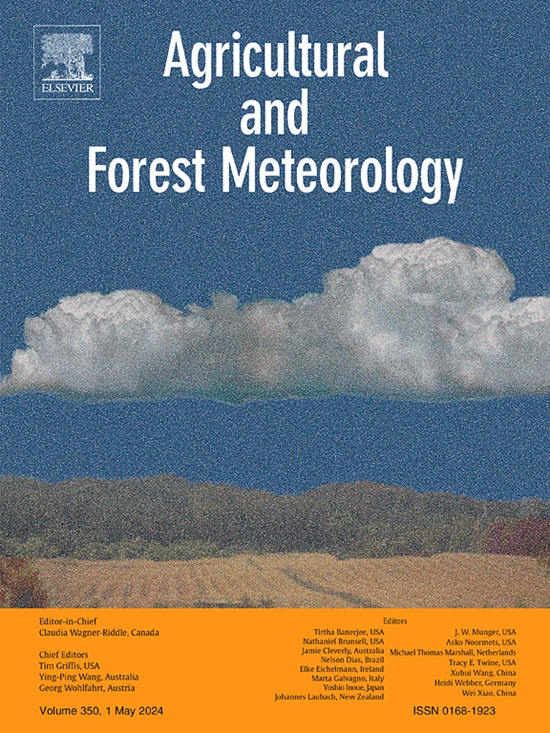遥感监测棉花黄萎病严重程度分级的实用方法
IF 5.6
1区 农林科学
Q1 AGRONOMY
引用次数: 0
摘要
疾病严重程度分级是棉花黄萎病综合治理的关键前提和重要方面。然而,目前的VW严重程度分级方法的应用需要对所有棉花叶片的疾病状况进行调查。它耗时长,与产量无关,难以反映实际严重程度,特别是在大规模遥感监测时。我们整合了棉花VW进展机制,探索不同叶型、不同棉花层叶片VW严重程度的潜力,以表明产量损失。基于棉花叶片1-3层的所有主茎叶(MLs)和1-5层的果枝叶(FLs),提出了一种适用于遥感监测的与产量损失相关的棉花VW分级方法——8位分级法(EPG)。结果表明,与ML相比,FL与产量的相关性更强,1-3层的ML和1-5层的FL有效地指示了VW造成的产量损失。将EPG与中国大众严重性评估技术规范(GB)及其相关分级方法进行了比较,证明了在修正GB分级中高估的同时,产量损失梯度为12%的性能。利用PROSPECT_D和mSCOPE对EPG的遥感适用性进行了理论验证。野外遥感试验证实,EPG在估算VW严重程度上具有较好的精度(R²= 0.76,RPD = 2.06),且与产量有较强的相关性(R²= 0.53)。本研究为科学评估VW严重程度和估算产量损失提供了简单实用的方法。本文章由计算机程序翻译,如有差异,请以英文原文为准。
A practical approach for grading cotton Verticillium wilt severity for remote sensing monitoring
Disease severity grading is a key prerequisite and major aspect of the integrated management of cotton Verticillium wilt (VW). However, the application of current VW severity grading methods requires an investigation into the disease status of all cotton leaves. It is time-consuming, unrelated to yield, and difficult to reflect the actual severity, especially when it comes to large-scale remote-sensing monitoring. We integrated the cotton VW progression mechanism exploring the potential of leaf VW severity in various leaf types at different layers of cotton to indicate yield loss. Based on all main stem leaves (MLs) in cotton leaf layers 1–3 and fruit branch leaves (FLs) in layers 1–5, we proposed a practical grading method for cotton VW associated with yield loss and suitable for remote sensing monitoring, termed the Eight-Position Grading method (EPG). The results indicated FL exhibited stronger correlation with yield compared to ML, and MLs in layers 1–3 and FLs in layers 1–5 effectively indicated yield loss due to VW. EPG was compared with the technical specifications for VW severity assessment in China (GB) and its associated grading methods, demonstrating performance with a 12 % yield loss gradient while correcting overestimation in GB grading. The remote sensing applicability of EPG was theoretically validated using PROSPECT_D and mSCOPE. Field remote sensing experiment confirmed that EPG achieved preferable accuracies in estimating VW severity (R² = 0.76, RPD = 2.06) and demonstrated a strong correlation with yield (R² = 0.53). This study offers a simple and practical method for scientifically assessing VW severity and estimating yield loss.
求助全文
通过发布文献求助,成功后即可免费获取论文全文。
去求助
来源期刊
CiteScore
10.30
自引率
9.70%
发文量
415
审稿时长
69 days
期刊介绍:
Agricultural and Forest Meteorology is an international journal for the publication of original articles and reviews on the inter-relationship between meteorology, agriculture, forestry, and natural ecosystems. Emphasis is on basic and applied scientific research relevant to practical problems in the field of plant and soil sciences, ecology and biogeochemistry as affected by weather as well as climate variability and change. Theoretical models should be tested against experimental data. Articles must appeal to an international audience. Special issues devoted to single topics are also published.
Typical topics include canopy micrometeorology (e.g. canopy radiation transfer, turbulence near the ground, evapotranspiration, energy balance, fluxes of trace gases), micrometeorological instrumentation (e.g., sensors for trace gases, flux measurement instruments, radiation measurement techniques), aerobiology (e.g. the dispersion of pollen, spores, insects and pesticides), biometeorology (e.g. the effect of weather and climate on plant distribution, crop yield, water-use efficiency, and plant phenology), forest-fire/weather interactions, and feedbacks from vegetation to weather and the climate system.

 求助内容:
求助内容: 应助结果提醒方式:
应助结果提醒方式:


